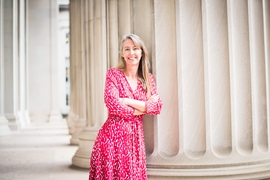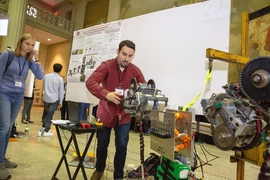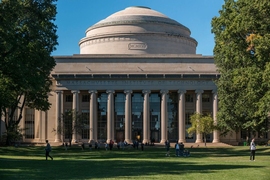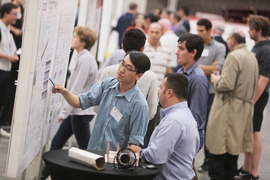Antje Danielson loves summer. And it’s not just the weather or the lighter traffic around campus. It’s the UROPs, she says.
Common enough to be referred to as a verb as well as a noun, MIT’s Undergraduate Research Opportunities Program (UROP) gives students the opportunity to do advanced work alongside professors and graduate students. Danielson, the director of education for the MIT Energy Initiative (MITEI), says undergraduate research isn’t just one of the “best-known and best-loved” features of the undergraduate experience at MIT.
It’s also “one of the most important ways we help students prepare to put MIT’s 'mens-et-manus' ['mind-and-hand'] motto into practice,” she says.
And, she adds, summer research is especially valuable because it lets students focus on one project with limited interruption. With MITEI, summer UROP students get an additional layer of experience. “The MITEI UROP is special because we encourage contact between industry sponsors and students, and because we help bridge disciplines to prepare the next generation of energy innovators and leaders no matter what their eventual career path,” Danielson says. “We also add extra programming that provides students the experience of professional life outside the lab.”
In the lab
Amy Glasmeier is no stranger to having UROP students in her lab.
“I’ve learned that as a principal investigator it’s critical to have a good match between the lab’s needs and the student’s needs,” says Glasmeier, a professor of economic geography and regional planning. After all, she explains, undergraduate researchers aren’t just assistants or technicians. They require additional engagement with faculty and graduate students before their work can contribute to a larger research project.
For example, she says, students who are mostly familiar with clearly delineated problem sets and calculations might struggle with nonstandard, unstructured data or project instruction. Her 2018 summer student, then-rising sophomore mechanical engineering major Taimor Williams, quickly vaulted over that obstacle. “Taimor has the intellectual flexibility and adaptability this project needs. I was able to just give him a big stack of reading on grid design, energy policy, data structures, and physics, to put it all in context,” says Glasmeier.
That’s important, she believes, because “you need the context of multiple scientific disciplines as well as social sciences and humanities to make the work relevant.”
Williams is characteristically modest about the amount of work he did to get started, saying only that “it was a lot of information, but manageable.” With an understanding of the literature in hand, Williams moved on to organizing qualitative descriptions of past electric system failures into data sets that can be analyzed programmatically. The ultimate goal is to identify patterns of system behavior that can be used to predict and prevent future outages.
Professional development
Over the past two years, MITEI Undergraduate Academic Coordinator Rachel Shulman has designed and built a program that brings students together across disciplinary boundaries and prepares them to be colleagues as well as researchers. This year, she had 25 participants. MITEI funded 19 of them, including four who came from Wellesley College. The students had supervisors representing 10 departments across campus.
A key part of their UROP experience was participating in MITEI’s professional development workshops, which are designed to provide support and guidance to make an undergraduate’s contributions more valuable. Together, the workshops build critical skills not taught in the lab or the classroom, such as library research; scientific and policy communication; professional networking and career planning; and poster design.
“Being a researcher isn’t just doing the lab work,” Shulman says. “That’s why we do these professional skills workshops and why we make sure all the students can communicate their research to different kinds of audiences.” In all fields, but especially in energy, it’s important to be able to reach across disciplines to build professional relationships; chemists and engineers and software developers and economists all need to be able to work together. And of course, she adds, “they’ll need to bring these ideas out of the lab as well, and explain them to general audiences.”
Students echo her statement: “You don’t learn this in class,” says junior Luke Hartnett, a mechanical engineering major. Working on biomass gasification with Leslie Bromberg, a principal research engineer in the Plasma Science and Fusion Center, and Emmanuel Kasseris, a mechanical engineering research scientist, was his first taste of professional lab work.
“Seeing my PI and the postdocs bouncing ideas off each other is just incredibly exciting. I feel like I’m getting a much better feel for what it’s like to work in the field in real life,” he says. At the same time, he’s also taken to heart advice to prepare a general-audience explanation of the work. “If I’m doing something really important,” he says, “I want to be able to tell everybody about it, not just my lab-mates.”
Alpha Yacob Arsano, a graduate student in architecture, says the workshops help students contribute more, and more quickly. She’s supervising Wellesley College computer science senior Chloe Blazey in the development of software to evaluate thermal comfort and performance of energy-efficient buildings for different climates. Blazey’s work as a computer science student was largely focused on abstract problem sets, so she needed research skills to rapidly gain a broad understanding of architecture and sustainable design.
“Chloe has already been using the lessons from the library session,” Arsano says, “and after just a couple of weeks she’s really helping to accelerate the work we’re doing.”
Blazey agrees that having a guide to the MIT library’s specialized academic research tools helped her adjust to working in architecture. It has also changed the way she sees her course of study. “I used to just think about computer science careers as being programming jobs,” she says. “It’s really opened my eyes to see the real-world applications of the theory I’ve been working on and how many different places my major can take me.”
Presenting the research
The culmination of the summer UROP experience is a presentation at the poster session at the MITEI Annual Research Conference in the fall. Shulman says that MITEI puts the UROPs alongside graduate students, research scientists, and professors to “really experience what it’s like to present their work in a professional context.”
Shulman brought in Writing and Communication Center lecturer Thalia Rubio to help the students prepare. In several meetings over the summer, she gave them a crash course in the research poster, a scientific communication format that most students don’t get to practice.
“They’re very familiar with term papers and lectures,” says Rubio. “They’ve done presentations. But a poster session uses different skills they don’t get much chance to exercise: design, very concise writing, and a presentation style that’s much more of a conversation than a lecture.”
Poster sessions are a key way for researchers to share work in progress and gain exposure to different perspectives on their work before they prepare it for publication. She has students practice creating posters and presentations for made-up topics like whether chewing gum improves mental concentration. Then, they get questions they aren’t prepared for: How do you know your measurement of concentration was a good one? What has previous research shown? Did you try different flavors of gum? What about organic versus conventional gum?
Obviously, says Rubio, it’s not about gum. It’s about how to handle questions that you haven’t considered.
“You’re going to get a question you aren’t prepared to answer, so be prepared to ask for their contact information and get back to them later,” she tells the students. She encourages them to learn from their oversights as well, noting that the feedback from a poster session can be incorporated into future research.
Bringing students together
Shulman has designed the student programming to reflect the inherent interdisciplinary nature of energy research.
“We’re aiming for cross-pollination,” she says. “That’s one reason we don’t limit professional development work to students we fund or supervise.”
Leon Glicksman, a professor of building technology and mechanical engineering, agrees. He enjoys being able to see students tackle real-world problems and encourages them to focus on the issues that lie between different academic disciplines.
“MITEI doesn’t have a single lab location, and although it doesn’t sound like it, that’s actually an advantage,” he says. “It prevents us from being cordoned off from other departments, initiatives, labs, and research centers. I like to tell students that energy is a great career for everyone, because the need to generate, distribute, and conserve energy isn’t going anywhere, and energy problems need people with lots of different skills and backgrounds to solve them.”
For example, Jose Soto Rivera, a junior in electrical engineering and computer science, is working with MITEI Deputy Director for Science and Technology Robert Stoner on a project about grid resilience in Puerto Rico. Without the workshops from the MITEI summer UROP, he might not have met Williams, whose work on infrastructure resilience in general may inform future grid designs. Neither of them would have met mechanical engineering students Cole Legg, a mechanical engineering junior who’s modeling waste-to-energy systems under Professor Ahmed Ghoniem, or sophomores Hartnett and Jimmy Tran, who are working on biomass gasification.
Their collaboration so far has been limited to speculative conversations over lunch; after all, they still have to finish their current research projects. But it’s possible that sometime in the future you might hear about a groundbreaking project that supplies hard-to-serve areas with reliable, low-carbon energy by combining smart grids, waste-to-energy systems, and biomass gasification — undertaken by students who met as UROPs in 2018.
The important thing for professors and investigators to remember, Glasmeier says, is that “a UROP is a gift.” Whether funding comes from MITEI, the MIT UROP office, or the lab itself, “having a UROP means having the ability to really watch someone develop as a researcher and as a person.”
This article appeared in the Autumn 2018 issue of Energy Futures, the magazine of the MIT Energy Initiative.













